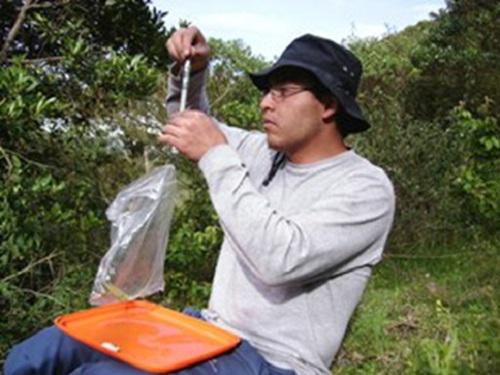Rafael Ángel Moreno Arias
In this project I will determine the population status and its relationship with the environmental characteristics of three highland Colombian endemic lizards Anolis heterodermus, Stenocercus trachycephalus and Anadia bogotensis.
I will make workshops and educational materials for local people about of lizards populations status and the main habitat needs of each species in order to built knowledge and awareness on conservation of the lizards and their habitat.

Measuring lizards.
The Tropical Andes is the ecoregion with the largest number of endemic species and more concentration of species in the world. But In Colombian Andes especially in the Cordillera Oriental due to high human population density and the expansion of urban and agricultural frontier only remain about one third of the Andean ecosystems. In the Sabana de Bogotá and the surrounding area these same activities are responsible of the loss of more than half plant communities.

Anadia bogotensis.
Habitat loss and fragmentation are the main threats to biodiversity because they alter demographic processes that affect the stability and persistence of animal wild populations. However the reptiles have been barely studied with relation to the effects of the habitat loss and fragmentation on their populations. Despite their restricted distribution and the threatened status of their habitats Colombian Andean lizard populations are poorly known.
I will study the population dynamics of three lizards (Anolis heterodermus, Stenocercus trachycephalus and Anadia bogotensis) at scrubland forest fragments in the Sabana de Bogotá. First I will characterize each fragment according its size, shape and vegetation structure. Second, I will capture-mark and release lizards then I will estimate size, survival and population dynamics. Finally, I will design educational materials and make workshops to spread information about population status, main threats and habitat needs of each lizard.
I will document the population status of these lizards and the consequences of the habitat loss and/or fragmentation in their demographics processes, persistence and future trajectories. This information in turn can help plan conservation strategies based on the maintenance of the most relevant demographics processes of each one population. Trough spread the results it will build awareness in local people about its active role in highland lizards and their habitat conservation for the future generations. I hope this project will be the baseline for long-term monitoring of these lizards.